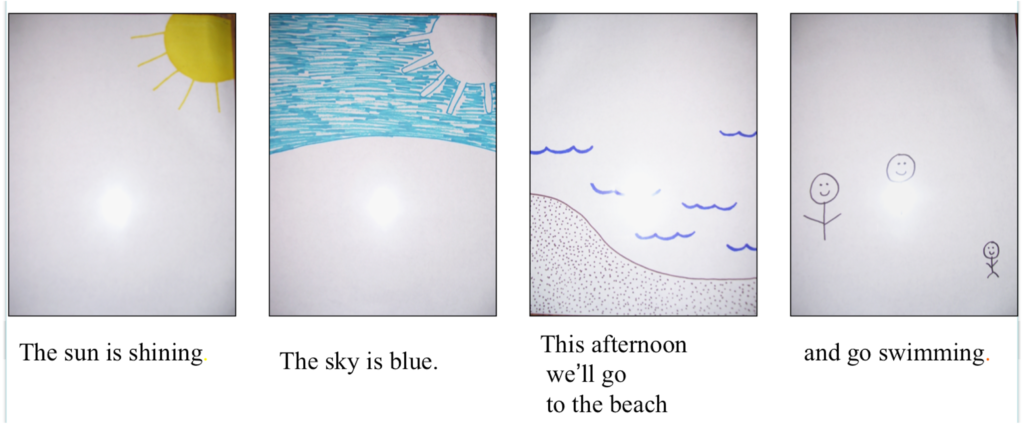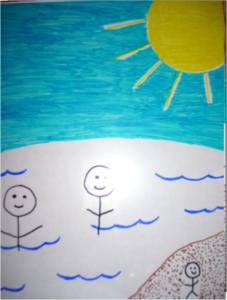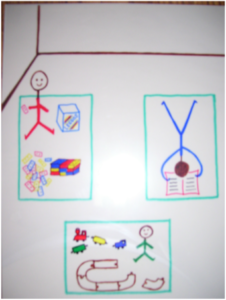This is the first part of a blog series with this outline
Part One: Creating Pictures in Layers With Two Take and Make Visual Examples
Part Two: Changing or Replacing a Layered Picture With One Take and Make Visual Example
Part Three: Creating, Changing and Replacing Pictures Conclusion
During childhood I was institutionalized. One day, some girls in the dayroom were busy writing a story. As they talked, their words went up on the movie screen I could see in my mind. Their words produced a picture for me. This is one way my visual thinking works. Then, all of a sudden, the girls changed part of their story. One girl tipped her pencil upside down, erased a few lines, and wrote in a new version.
Typically, this would mean I’d have to destroy the picture on the screen in my head if I wanted to continue to listen to the conversation. I had not yet developed a way to erase parts of my pictures. But that day I realized if my pictures were created in layers, rather than on one page, I would be able to keep up when the story changed. I would be able to trade in an old layer for a new one! It would be my way of erasing and changing something. And, the changing picture would still fit on that one screen I could see in my mind.
It took a lot of practice, but as I continued to work with the idea of creating pictures in layers I found that I became a little more flexible. I hoped that with practice I would one day be just as quick as anyone else in keeping up, i.e. understanding changing content of conversations in the world all around me. I was not disappointed!
My work paid off and over time I have perfected this strategy. I am many years older now and continue to work with these ideas. Over the years I’ve trained myself to create pictures in layers. Learning this skill became my foundation for beginning to live successfully in the world of words. Once I was a teenager who lived in a mental institution. Today, I function quite well in the world both in my personal life and in my professional life having accomplished many things.
I have since perfected this strategy and have used it with many visually thinking students to help with reading comprehension. Additionally, it has had application in the clinical setting in easing frustrations that come when clients perceive “everything changed” when in reality only one element of a big picture changed. Additionally, this layered thinking is helpful clinically in terms of supporting clients in changing patterns of thinking that are not working well for them.
To illustrate how thinking in layers works I will use the following two stories.
Story One:
Going to the Beach
1. The sun is shining.
2. The sky is blue.
3. This afternoon we’ll go to the beach
4. and go swimming.
Directions for Making a Visual Using Story One: Going to the Beach
Materials: 4 clear overhead projector sheets, and a permanent marker pens in yellow, blue, brown and black
- Using the yellow pen, draw on the first overhead projector sheet the shining sun.
- Placing a new clear sheet over the sun, draw the blue sky on this second overhead projector sheet as it fits with the sun.
- Placing another new clear sheet on top of the existing two layers and the brown pen, draw the beach as it fits with the sun and sky.
- Placing the last clear sheet on top of the existing three layers, draw children swimming as it fits with the other three layers.
Here are the picture elements, each recorded separately – each element drawn on its own overhead projector sheet. (Note: In the book Autistitically Thriving, there are templates in the back of the book you may use by simply covering with a clear overhead and tracing the picture onto the overhead.)
Each layer was made separately as shown in above photo, but as they were drawn clear sheets were stacked up one on top of the other to create the whole picture. Stacked together, the final layered picture looks like this:
~~~~~~~~~~~~~~~~~~~~~~~~~~~~~~~~~~~~~~~~~~~~~~~~~~~~~~~~~~~~~~~~~~~~~~~
Story Two:
Playing Indoors
1. This afternoon we will play indoors.
2. We will each play in our own space.
3. I will play with Legos.
4. My brothers will play with something else.
Directions for Making a Visual Using Story Two: Playing Indoors
Using 4 overhead projector sheets, permanent markers, and working as in Story One,
create Story Two to get this end result:
Each layer was made separately as shown in above photo, but as they were drawn clear sheets were stacked up one on top of the other to create the whole picture. Stacked together, the final layered picture looks like this:
~~~~~~~~~~~~~~~~~~~~~~~~~~~~~~~~~~~~~~~~~~~~~~~~~~~~~~~~~~~~~~~~~~~~~~~
If you are a clinician and interested in learning more about therapy with the autistic client please join me along with two of my colleagues in an online course.
CLICK HERE for additional information about Mental Health Therapy with the Autistic Client. 
Note: The author is a mental health therapist and is also autistic. She iintentionally uses identity-first language (rather than person-first language), and invites the reader, if interested, to do further research on the preference of most autistic adults to refer to themselves using identity-first language.
This blog series is based on Chapter 9 from Autistically Thriving:Reading Comprehension, Conversational Engagement, and Living a Self-Determined Life Based on Autistic Neurology, pg. 126-133.
BOOKS BY JUDY ENDOW
Endow, J. (2021). Executive Function Assessment. McFarland, WI: Judy Endow.
Endow, J. (2019). Autistically Thriving: Reading Comprehension, Conversational Engagement, and Living a Self-Determined Life Based on Autistic Neurology. Lancaster, PA: Judy Endow.
Endow, J. (2012). Learning the Hidden Curriculum: The Odyssey of One Autistic Adult. Shawnee Mission, KS: AAPC Publishing.
Endow, J. (2006). Making Lemonade: Hints for Autism’s Helpers. Cambridge, WI: CBR Press.
Endow, J. (2013). Painted Words: Aspects of Autism Translated. Cambridge, WI: CBR Press.
Endow, J. (2009b). Paper Words: Discovering and Living With My Autism. Shawnee Mission, KS: AAPC Publishing.
Endow, J. (2009a). Outsmarting Explosive Behavior: A Visual System of Support and Intervention for Individuals With Autism Spectrum Disorders. Shawnee Mission, KS: AAPC Publishing.
Endow, J. (2010). Practical Solutions for Stabilizing Students With Classic Autism to Be Ready to Learn: Getting to Go. Shawnee Mission, KS: AAPC Publishing.
Myles, B. S., Endow, J., & Mayfield, M. (2013). The Hidden Curriculum of Getting and Keeping a Job: Navigating the Social Landscape of Employment. Shawnee Mission, KS: AAPC Publishing.



